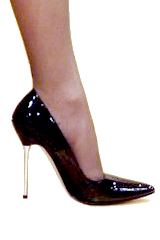 Image via Wikipedia
Image via WikipediaAs you watched the
Oscars a couple weeks ago, what amazed you more, the dresses or the shoes? Remember when the fashion news included who the stars’ dress designer was? Well now the commentary isn’t complete unless we know who the shoe designer is also. This is all well and good, but to spend so much money on something that you can’t stand to be in for more than a few minutes, seems extravagant, even for Hollywood. On February 26th, our favorite girl next door,
Sandra Bullock, attended a pre-Oscar party wearing black pants, a black lace top, white jacket and a pair of black and white stilettos. A couple of hours after arriving at the party, she was seen leaving, with shoes in hand. She was walking the concrete carpet in her bare feet! Now that makes more sense.
It really doesn’t make sense to become such a slave to fashion. Women are willing to undergo hours of torture and torment by cramming their feet into ill formed, poorly fitting shoes that force them to mince along, teetering like they are walking a cliff’s edge. All attention is focused on how to maintain an unnatural balance, with a fake smile glued to the face, which covers the pinched expression the face would make and give away the painful feeling in the feet.
Understand that Hollywood egos are all about glamour and one-upsmanship, but really, can’t a shoe designer make an attractive pair of shoes with a two inch heel? Why do heels have to be six inches high? The foot is forced into such an unnatural position, all of the weight bearing being done on the ball of the foot. Feel the neuromas developing now. Oh, the burning pain from the friction.
The logical thing to do would be to start a new trend. A designer who could actually make a shoe with a modest two inch heel and one that is elegant enough to wear with haute couture. Now that designer could really create a niche for himself in the marketplace. Until that happens, though, women will probably continue to stumble and trip along the red carpet, complain about their sore, tired feet and doff their shoes at the first opportunity. Meanwhile, Hollywood podiatrists can continue to offer post-Oscar specials.
Do you love wearing
high heels, but struggle with foot pain afterward? What do you do to relieve the pain? Comment below, we would love to hear from you. Also, if you would like more information about foot pain and high heel wear, please contact
Dr. Blaakman at (877) 941-FEET (3338).

















